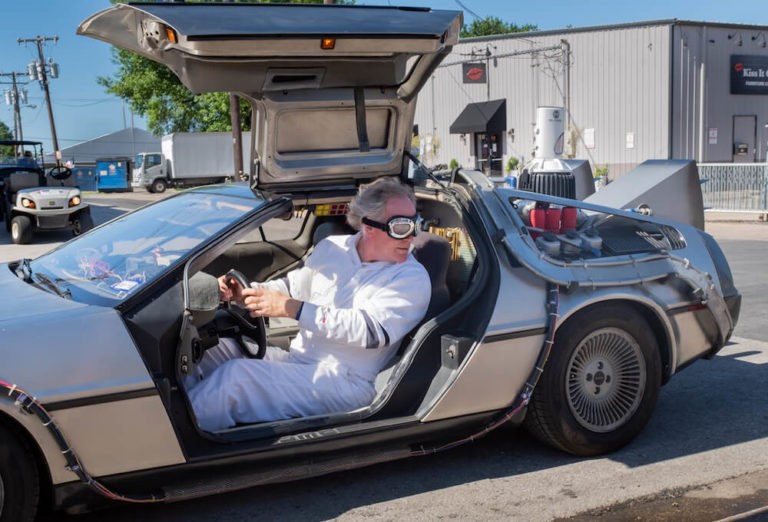What is Back to the Future Day?
Hop in your DeLorean and buckle your seatbelt as you begin to take a journey “back to the future.” Back to the Future Day is celebrated on October 21st each year because that is the date that Marty McFly and Doc Brown traveled into the future in the popular 1985 movie, Back to the Future. Marty was on a course to change his own destiny and the pair encountered many surprises on their futuristic adventure. This beloved movie has been watched for many years, and it can bring a lot of different learning opportunities into the classroom.
How Can Students Benefit from Back to the Future Day?
As a teacher, making student learning relatable to the real world is a way to get their attention. There were a lot of cool and accurate predictions in the movie including Facetime-like communication, voice recognition, targeted advertisements, and thumbprint technology. You can ask some higher-level questions to students in a discussion of what the movie got right and what the movie got wrong, and even have students make predictions for 30 years in the future.
This provides you with a way to help students learn how to reflect, as well as embrace teachable moments of how and why to set goals. For example, what is something that the student wants to accomplish and be proud of in the future? This question can incorporate discussions of points of pride for students currently, and can be wrapped into a social-emotional learning (SEL) lesson which is a major focus in education at this time as we are still navigating a pandemic.
The movie portrayed a future full of technology and presents many great opportunities for students to engineer their own inventions. The movie depicted a weather service that controlled the weather patterns, flying cars and hoverboards, holographic movie trailers, and self-drying jackets, amongst many other things. This movie shows students that anything is possible and that science relates to many parts of life. Watching this movie is a great way to get students excited about science and about how much can change in the next 30 years and beyond!
How to Celebrate Back to the Future Day in your Class
Make Your Own Flux Capacitor
This video will walk you through creating your very own flux capacitor. You will need some basic items such as a cardboard box, spray paint, LED rope lights, galvanized wire, transparencies, duct tape, and labels in order to make your final product. You don’t have to use the exact materials mentioned in the video, but it is best practice to gather all of your materials before beginning.
This is a great project to create in a STEM class or to use in a science class to show students how to work through the engineering process. The flux capacitor made time travel possible in the movie, and it can be exciting for students to create their own and think about where (and when) it could bring them to!
Invention Convention
Students at any age and grade level can participate in an Invention Convention by working through the engineering design process to create a prototype of their invention. This type of activity brings 21st-century skills to students with hands-on, real world, project-based learning.
Students are able to explore their creativity and come up with some really cool ways to solve real-world problems. This requires a lot of thinking, creating, testing, recreating, and a bit of a sales pitch to sell this product to the other students. You can incorporate other subject areas such as mathematics and ELA into this project, as you can have students work on their persuasion and presentation skills, as well as come up with statistics as to why this invention is necessary to the world.
Make Lightning
The National Weather Service has a few experiments where students can make lightning. A more basic one is using Wint-O-Green or Pep-O-Mint lifesavers, a dark room, and a mirror to see the electrical charges that can be produced when you crush up the lifesaver in your mouth.
A second, and a bit more complex, experiment is one where you use a few different materials such as an aluminum pan, wool fabric, Styrofoam plate, pencil with a new eraser, and a thumbtack to create static electricity and create a spark. These are great little activities to get students interested in learning about lightning at any grade level. The lightning strike is iconic in Back to the Future, so this makes for a simple activity to create your own!
Hot Wheelin’
This is a great activity to incorporate data collection and graphs into science. Students will use different types of toy cars and remote control vehicles to have speed trials and then use the data they collect in order to analyze the speed of the vehicles between particular points. This is an excellent way to promote group work, as well as roles within a group. This lesson includes a student handout and a student practice sheet.
Balloon Rocket Car
This may not exactly be a DeLorean vehicle, but you can make your own balloon rocket car! The activity can bring students to travel into the world of physics and figure out how to make the fastest balloon rocket car through different trials of how to propel the car.
Back to the Future Day can be a fun way to engage students in learning more about engineering and the sciences through these science experiments. Back to the Future was full of technological advancements that no one could imagine when the original movie came out in 1985. It shows students that anything is possible, even things beyond your wildest imagination. With the technology we have in our modern-day world, it is hard to fathom what will happen in the next 10, 20, and 30 years. A great imagination can lead to wonderful creations that can have a significant impact on the world now and for years to come!




